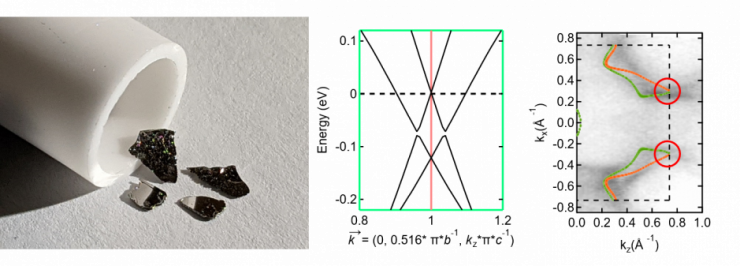A new type of superconductor

center: the linear dependence of energy with momentum from the electronic structure calculations
right: the ARPES measurements (gray scale) and the calculated momentum (orange and green line) showing the band touching (in the red circle)
The phenomenon of superconductivity continues to challenge our understanding of materials. In all superconductors, materials that can carry electricity without any resistance, the charge carrier unit is a pair of electrons called a Cooper pair. Below the superconducting transition temperature, Tc, they enter a coherent ground state called a “condensate”. In unconventional superconductors, these condensates typically have lower symmetries than in conventional superconductors. These symmetries resemble the ones of atomic orbitals, and give rise to the classification of superconductors as s-wave, p-wave, d-wave, f-wave.
Because of a quantum property of electrons which have half-integer spin, the Cooper pairs must be antisymmetric under exchange of electrons. This rule constrains the symmetry of the spin: s-wave and d-wave superconductors are in a so-called spin-singlet state, whereas p-wave and f-wave superconductors are in a spin-triplet state. A team of three faculty groups in the Department of Physics and Astronomy joined their expertise to study a new type of superconductor in which the Cooper pairs have a s-wave spin-triplet symmetry. This weird combination is enabled because the Cooper pairs are formed from a special type of electrons, called Dirac fermions. These Dirac fermions have a linear dependence of their energy with respect to momentum: they behave as if they have no mass.
The UC Davis team found this property in the material LaNiGa2. Graduate student Jackson Badger in the group of Prof. Taufour developed a technique to grow single crystals of this material for the first time. They were able to identify a very peculiar crystal structure with a particular type of symmetry, known as a two-fold screw axis. Such symmetry imposes weird degeneracies (“band touching”) for the wave functions of the electrons, known as Dirac points.
They joined their effort with the group of Warren Pickett to calculate the electronic structure of LaNiGa2 and find the momentum of the Dirac electrons. To confirm their calculations, they worked with the group of Prof. Inna Vishik who specializes in measuring the energy versus momentum
(dispersion) relations of electrons in materials. Their experimental results were in excellent agreement with the calculations. LaNiGa2 provides the first example of a topology induced s-wave spin-triplet superconductor. These findings will enable future discoveries of additional topological superconductors, which may one day have applications in fault-tolerant quantum computing.
Published: June 2, 2021, 4:30 pm
